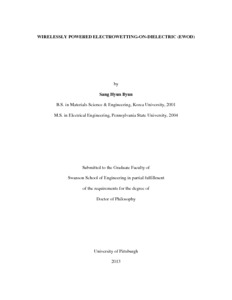BYUN, SANG HYUN
(2013)
Wirelessly Powered Electrowetting-on-Dielectric(EWOD).
Doctoral Dissertation, University of Pittsburgh.
(Unpublished)
![[img]](http://d-scholarship.pitt.edu/19313/1.hassmallThumbnailVersion/byunsh_ETD2013.pdf)  Preview |
|
PDF (The final version after correction.Each entry in the bookmark panel has been corrected to direct actual entry in the text.)
Primary Text
Download (5MB)
| Preview
|
Abstract
Electrowetting-on-dielectric (EWOD) allows us to control wettability of droplets on a solid surface using electrical inputs and has been used in a wide range of applications including microfluidics, optical displays, lenses, and others. To date, however, they all have been powered in wired connections, limiting their further employments in hard-to-reach area particularly for implantable EWOD devices. One way to deal with the presented issue, a wireless EWOD system is studied and developed. Due to compatibility of EWOD with AC (less than 1 kHz), a wireless powering as prompt method is achieved by a magnetic induction which essentially utilizes AC signal. The wireless powering with droplets actuation is verified in both using spool-type coils and planar coils. In the spool-type wireless EWOD study, the induced voltage at the receiver is much higher (~390 V) than typically required EWOD voltages (at least >50 V), which is sufficient to actuate the droplets. For reliable wireless EWOD actuation, the voltage induction has to be higher than the conventional EWOD while the current does not have to be necessarily high. Since the voltage induction is proportional to the transmission frequency, a higher voltage can be obtained by increasing the transmission frequency. However, if the transmission frequency is too high, the actuation of droplets might be limited. For an efficient EWOD actuation even at such a high transmission frequency, the system might need to be incorporated with an external demodulation circuit. This issue is addressed in the planar wireless EWOD system in which the powering devices and EWOD electrodes are integrated by standard photolithography process. To oscillate droplets while in lateral actuation irrespective of the coil type, amplitude modulation (AM) technique is applied to the wirelessly transmitted signal. Droplet oscillations are often introduced in many applications and beneficial to reduce the contact angle hysteresis. Eventually, by employing the compact wireless EWOD system into particle collecting and mini-boat propulsion, the unnecessary and cumbersome wire connections between the device components are significantly reduced, and more convenient and flexible EWOD operation is achieved with less constraint of the space and equipment.
Share
| Citation/Export: |
|
| Social Networking: |
|
Details
| Item Type: |
University of Pittsburgh ETD
|
| Status: |
Unpublished |
| Creators/Authors: |
|
| ETD Committee: |
|
| Date: |
25 September 2013 |
| Date Type: |
Publication |
| Defense Date: |
4 June 2013 |
| Approval Date: |
25 September 2013 |
| Submission Date: |
11 July 2013 |
| Access Restriction: |
No restriction; Release the ETD for access worldwide immediately. |
| Number of Pages: |
121 |
| Institution: |
University of Pittsburgh |
| Schools and Programs: |
Swanson School of Engineering > Materials Science and Engineering |
| Degree: |
PhD - Doctor of Philosophy |
| Thesis Type: |
Doctoral Dissertation |
| Refereed: |
Yes |
| Uncontrolled Keywords: |
Electrowetting-on-Dielectric (EWOD), Wireless, Magnetic Induction, Amplitude-Modulation (AM), Microfluidics. |
| Date Deposited: |
25 Sep 2013 14:50 |
| Last Modified: |
15 Nov 2016 14:14 |
| URI: |
http://d-scholarship.pitt.edu/id/eprint/19313 |
Metrics
Monthly Views for the past 3 years
Plum Analytics
Actions (login required)
 |
View Item |








